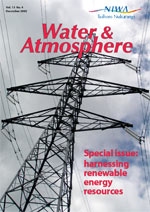PDF of this article (53 KB)

One of NIWA’s aims with this magazine is to contribute to science education in New Zealand. To this end we distribute Water & Atmosphere without charge to New Zealand high schools. Most of the magazine’s articles are assigned ‘Curriculum Connections’ to indicate which of the NZ NCEA Achievement Standards they can complement as a classroom resource. These links are assigned by Royal Society of New Zealand Teacher Fellows who are working during the year with NIWA scientists.
Remember that there is an Archive of past issues beginning with September 2000 (vol. 8, no. 3). All online articles include a pdf of the printed version and the articles are indexed via the website’s search engine.
Curriculum connections for this issue
| Article | Relevant NCEA Achievement Standards | Brief summary |
|---|---|---|
| Finding New Zealand’s renewable energy resources | Science 90191 (1.6) Mathematics 90193 (1.5) | Long-term data collections, and techniques such as climate mapping, help quantify energy resources and predict demand. |
| Hydropower: innovation based on knowledge | Science 90191 (1.6), 90313 (2.2) Geography 90336 (2.6) | Hydropower is a key component of NZ’s energy resource and can work at a range of scales. |
| Wind and wind energy | Science 90191 (1.6), 90313 (2.2) Geography 90207 (1.6) | Developing wind as an energy resource requires detailed knowledge of where winds are strongest and most consistent. |
| Solar energy | Science 90191 (1.6) Physics 90253 (2.2) | Ground-based and satellite measurements can tell us the size and variability of NZ’s solar energy resource. |
| Ocean bounty: energy from waves and tides | Science 90191 (1.6), 90313 (2.2) Physics 90254 (2.3) | Measurement and modelling underpin efforts to quantify the resource and develop devices for harvesting energy from the sea. |
| Energy in rural Māori communities | Science 90191 (1.6), 90313 (2.2) Geography 90207 (1.6) | Retrofitting for energy efficiency and installing small-scale renewable-energy generators have helped two rural communities. |
| Energy from wastewater treatment | Science 90191 (1.6), 90313 (2.2) | Algae in specially designed farm ponds can treat wastewater and provide energy in the form of biogas. |
| Timely information for energy operations | Science 90191 (1.6) | Energy providers rely on data from the National Hydrometric Network to predict how much electricity they can produce. |
| Managing risk in energy supply | Science 90191 (1.6), 90313 (2.2) | NIWA’s risk-assessment studies help power providers effectively manage risk, such as that posed by natural hazards. |
| Climate variability, climate change, and energy | Science 90313 (2.2) Geography 90337 (2.7) | Climate affects the demand for energy and the resources available to provide it. Climate research helps energy providers balance the equation. |
